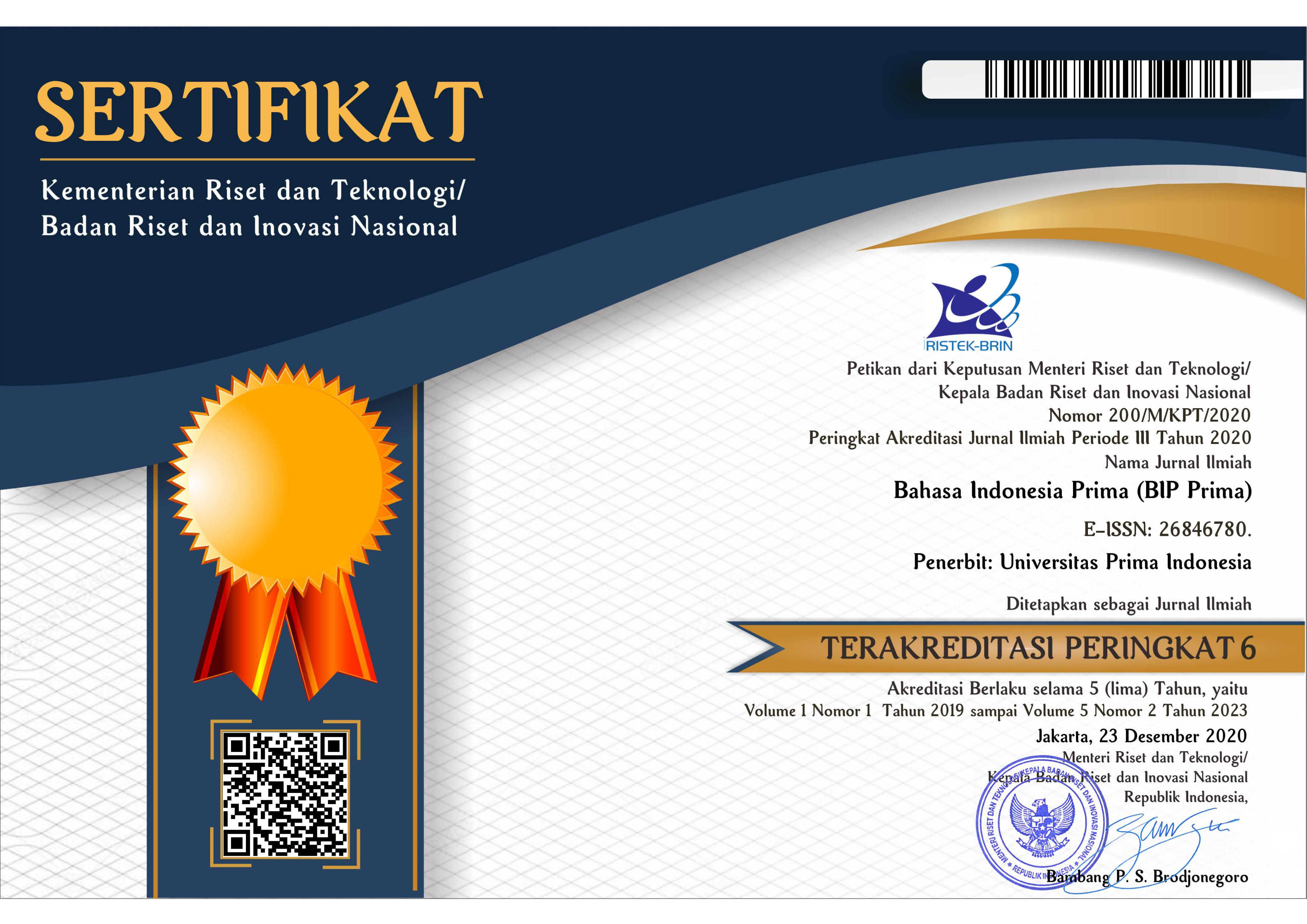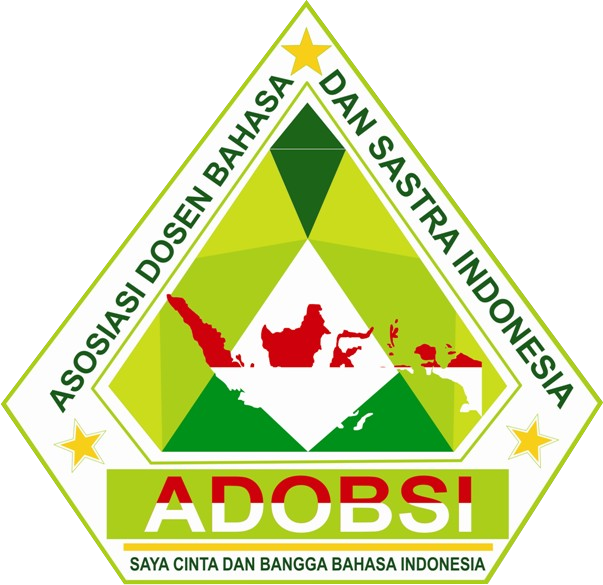PENILAIAN OTENTIK PADA KETERAMPILAN BERKOMUNIKASI SISWA SEKOLAH MENENGAH ATAS
DOI:
https://doi.org/10.34012/jbip.v4i1.2188Keywords:
penilaian, ketererampilan, berkomunikasiAbstract
Abstrak-Penelitian ini dilatarbelakangi masalah kurangnya kemampuan guru dalam menilai pembelajaran bahasa Indonesia. Salah satu keterampilan yang amat penting untuk dinilai adalah keterampilan berkomunikasi sebagai pondasi bagi siswa dalam arus perkembangan teknologi semakin canggih. Hal ini perlu dirancang sebuah model penilaian yang tepat digunakan oleh guru untuk menilai keterampilan berkomunikasi siswa. Penelitian ini berjenis penelitian pengembangan yang menggunakan model pengembangan ADDIE. Objek penelitian ini guru bahasa Indonesia Sekolah Menengah Atas Negeri 1 Gunungtua Padang Lawas Utara kelas XI yang terdiri atas dua kelas, yaitu XI-A dan XI-B yang berjumlah 90 orang siswa. Instrumen penelitian yang digunakan adalah angket validasi model, angket praktikalitas model, angket efektivitas model, pedoman wawancara, pedoman observasi, dan tes. Temuan penelitian ini menunjukkan bahwa model penilaian untuk menilai keterampilan berkomunikasi siswa kelas menengah atas valid, praktis, dan efektif digunakan oleh guru bahasa Indonesia.
References
Alkharusi, H. (2015). An evaluation of the measurement of perceived classroom assessment environment. International Journal of Instruction, 8(2), 45-54.
Angraini, Dhila Izza. (2021). Pengaruh Keterampilan Komunikasi terhadap Kesiapan Kerja Lulusan Sarjana Sumatera Barat. Jurnal Psikologi Islam Al-Qalb Vol. 12, No. 1, (2021). Doi: https://doi.org/10.15548/alqalb.v12i1.2444.
Aitken, E. N., & Pungur, L. (2005) Literature Synopsis: Authentic Assessment. http://education.alberta.ca/apps/aisi/literature/pdfs/Authentic_Assessment UofAb_Uofl.pdf.
Bordoh, A., Eshun, I., Quarshie, M., Bassaw, T.K., and Kwarteng, P. (2015). Social Studies Teachers’ Knowledge Base in Authentic Assessment in Selected Senior High Schools in the Central Region of Ghana. Journal of Social Science and Humanities, 1 (3) 249-257.
Borich, G. D., & Tombari, M. L. (2004). Educational assessment for the elementary and middle school classroom. Prentice Hall.
Branch, R.M. (2009). Instructional Design: The ADDIE Approach. New York: Springer.
Chatab, Nevizond. (2007). Profil Budaya Organisasi. Bandung: Penerbit Alfabeta.
Coniam, D. (2009). Investigating the quality of teacher-produced tests for EFL students and the effects of training in test development principles and practices on improving test quality. System, 37(2), 226-242.
Cheung. Lawrence. (2016). Using the ADDIE Model of Intructional Design To Teach Chest Radiograph Interpretation. Available https://www.hindawi.com/journals/jbe/2016/9502572/abs/.
Ching Yee Yong dkk. (2012). Gender As A Moderator Between Level of MATLAB Knowledge and MATLAB Features Understanding. International Journal of Education and Learning. www.sersc.org/journal/IJEL/vol1_no2.
Eggen, P., & Kauchack, D. (2004). Educational Psychology: Windows On Classrooms. New Jersey: Pearson Education, Inc.
Frey, B. B. (2013). Modern classroom assessment. SAGE Publications.
Gulikers, J. T., Bastiaens, T. J., & Kirschner, P. A. (2004). A five-dimensional framework for authentic assessment. Educational technology research and development, 52(3), 67.
Genesee, F. (2002). Evaluation. In R. Carter, & D. Nunan (Eds.), The Cambridge Guide to Teaching English to Speakers of Other languages (4th ed., pp. 144-150). Cambridge: Cambridge University Press.
Iriantara, Y. (2014). Komunikasi Pembelajaran. Bandung: Simbiosa Rekatama Media.
Kankam, B (2015). Teachers’ Perception of Authentic Assessment Techniques Practice in Social Studies Lesson in Senior High Schools in Ghana. Ghana: International Journal of Educational Research and Information Science.
Kang, O., Rubin, D., & Kermad, A. (2019). The effect of training and rater differences on oral proficiency assessment. Language Testing, 36(4), 481-504.
Koh, K. H. (2011). Improving teachers’ assessment literacy through professional development. Teaching Education, 22(3), 255-276.
Levi, T., & Inbar-Lourie, O. (2020). Assessment literacy or language assessment literacy: Learning from the teachers. Language Assessment Quarterly, 17(2), 168-182.
Marfuah (2017). Meningkatkan Keterampilan Komunikasi Peserta Didik melalui Model Pembelajaran Kooperatif Tipe Jigsaw. Jurnal Pendidikan Ilmu Sosial Vol 26, No 2, Desember 2017. http://ejournal.upi.edu/index.php/jpis.
Molenda, M. (2003). Performance Improvement, 42 (5), 34-36. Educational Technology: An Encyclopedia. http://www.indian.edu.
Mueller, J. (2005). The authentic assessment toolbox: enhancing student learning through online faculty development. Journal of Online Learning and Teaching, 1(1), 1-7.
Retnawati, Hadi, and Nugraha (2016). Vocational High School Teachers’ Difficulties in Implementing the Assessment in Curriculum 2013 in Yogyakarta Province Indonesia. International Journal of Instruction.
Rizki, Sfiyana et al. (2021). Peningkatan Keterampilan Berkomunikasi melalui Model Pembelajaran Kooperatif Jigsaw. Jurnal Bidang Pendidikan Dasar (JBPD) http://ejournal.unikama.ac.id/index.php/JBPD.
Sezer, Baris. 2013. “Integrating Technology Ito Classroom: the Learner-Centered Instructional Design”. Dalam International Journal on new Trend in Educationin Their Implication. Vol.4. No. 4. (www.iet-c.net/../ietc2013.pdf).
Vogt, K., & Tsagari, D. (2014). Assessment literacy of foreign language teachers: Findings of a European study. Language Assessment Quarterly, 11(4), 374-402.
Whitlock, B., & Nanavati, J. (2013). A systematic approach to performative and authentic assessment. Reference Services Review, 41(1), 32-48.
Downloads
Published
How to Cite
Issue
Section
License
Copyright (c) 2022 Jusrin Efendi Pohan

This work is licensed under a Creative Commons Attribution-ShareAlike 4.0 International License.

BIP: Jurnal Bahasa Indonesia Prima is licensed under a Creative Commons Attribution-Share Alike 4.0 International License.














